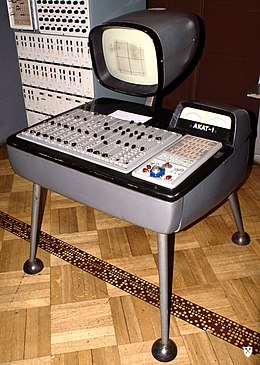Electronic analog computers


The similarity between linear mechanical components, such as springs and dashpots (viscous-fluid dampers), and electrical components, such as capacitors, inductors, and resistors is striking in terms of mathematics. They can be modeled using equations of the same form.
However, the difference between these systems is what makes analog computing useful. Complex systems often are not amenable to pen-and-paper analysis, and require some form of testing or simulation. Complex mechanical systems, such as suspensions for racing cars, are expensive to fabricate and hard to modify. And taking precise mechanical measurements during high-speed tests adds further difficulty.
By contrast, it is very inexpensive to build an electrical equivalent of a complex mechanical system, to simulate its behavior. Engineers arrange a few operational amplifiers (op amps) and some passive linear components to form a circuit that follows the same equations as the mechanical system being simulated. All measurements can be taken directly with an oscilloscope. In the circuit, the (simulated) stiffness of the spring, for instance, can be changed by adjusting the parameters of an integrator. The electrical system is an analogy to the physical system, hence the name, but it is much less expensive than a mechanical prototype, much easier to modify, and generally safer.
The electronic circuit can also be made to run faster or slower than the physical system being simulated. Experienced users of electronic analog computers said that they offered a comparatively intimate control and understanding of the problem, relative to digital simulations.

Electronic analog computers are especially well-suited to representing situations described by differential equations. Historically, they were often used when a system of differential equations proved very difficult to solve by traditional means. As a simple example, the dynamics of a spring-mass system can be described by the equation , with as the vertical position of a mass , the damping coefficient, the spring constant and the gravity of Earth. For analog computing, the equation is programmed as . The equivalent analog circuit consists of two integrators for the state variables (speed) and (position), one inverter, and three potentiometers.
Electronic analog computers have drawbacks: the value of the circuit's supply voltage limits the range over which the variables may vary (since the value of a variable is represented by a voltage on a particular wire). Therefore, each problem must be scaled so its parameters and dimensions can be represented using voltages that the circuit can supply —e.g., the expected magnitudes of the velocity and the position of a spring pendulum. Improperly scaled variables can have their values "clamped" by the limits of the supply voltage. Or if scaled too small, they can suffer from higher noise levels. Either problem can cause the circuit to produce an incorrect simulation of the physical system. (Modern digital simulations are much more robust to widely varying values of their variables, but are still not entirely immune to these concerns: floating-point digital calculations support a huge dynamic range, but can suffer from imprecision if tiny differences of huge values lead to numerical instability.)


The precision of the analog computer readout was limited chiefly by the precision of the readout equipment used, generally three or four significant figures. (Modern digital simulations are much better in this area. Digital arbitrary-precision arithmetic can provide any desired degree of precision.) However, in most cases the precision of an analog computer is absolutely sufficient given the uncertainty of the model characteristics and its technical parameters.
Many small computers dedicated to specific computations are still part of industrial regulation equipment, but from the 1950s to the 1970s, general-purpose analog computers were the only systems fast enough for real time simulation of dynamic systems, especially in the aircraft, military and aerospace field.
In the 1960s, the major manufacturer was Electronic Associates of Princeton, New Jersey, with its 231R Analog Computer (vacuum tubes, 20 integrators) and subsequently its EAI 8800 Analog Computer (solid state operational amplifiers, 64 integrators).[32] Its challenger was Applied Dynamics of Ann Arbor, Michigan.
Although the basic technology for analog computers is usually operational amplifiers (also called "continuous current amplifiers" because they have no low frequency limitation), in the 1960s an attempt was made in the French ANALAC computer to use an alternative technology: medium frequency carrier and non dissipative reversible circuits.
In the 1970s, every large company and administration concerned with problems in dynamics had an analog computing center, such as:
- In the US: NASA (Huntsville, Houston), Martin Marietta (Orlando), Lockheed, Westinghouse, Hughes Aircraft
- In Europe: CEA (French Atomic Energy Commission), MATRA, Aérospatiale, BAC (British Aircraft Corporation).
Construction
Analog computing machine consists of several main components:[33][34][35][36]
- Signal sources: These are blocks that generate analog signals, such as voltage or current, to represent input data and operations.
- Amplifiers: Amplifiers are used to boost analog signals and maintain their amplitudes throughout the system. They amplify weak input signals and compensate for signal losses during transmission.
- Filters: Filters are used to modify the spectrum of signals by suppressing or amplifying specific frequencies. They allow the isolation or suppression of certain signal components depending on the computational requirements.
- Modulators and demodulators: Modulators convert information into analog signals that can be transmitted through a communication channel, and demodulators perform the reverse transformation, recovering the original data from modulated signals.
- Adders and multipliers: Adders and multipliers perform arithmetic operations on analog signals. They can be used for mathematical operations such as addition, multiplication, integration, and differentiation.
- Storage and memory: Analog computing machines can use various forms of information storage, such as capacitors or inductors, to store intermediate results and memory.
- Feedback and control: Feedback and control blocks are used to maintain the stability and accuracy of the analog computing machine. They may include regulation systems and error correction.
- Patch panel: Analog computing machines also feature a patch panel or patch field. A patch panel is a physical structure on which connectors or contacts are placed to connect various components and modules within the system.
On the patch panel, various connections and routes can be set and switched to configure the machine and determine signal flows. This allows users to flexibly configure and reconfigure the analog computing system to perform specific tasks.
Patch panels are used to control data flows, connect and disconnect connections between various blocks of the system, including signal sources, amplifiers, filters, and other components. They provide convenience and flexibility in configuring and experimenting with analog computations.
Patch panels can be presented as a physical panel with connectors or, in more modern systems, as a software interface that allows virtual management of signal connections and routes.
- Hardware interfaces: Interfaces provide means of interaction with the machine, for example, for parameter control or data transmission.
- Output device: this device is designed to present the results of analog computations in a convenient form for the user or to transmit the obtained data to other systems.
Output devices in analog machines can vary depending on the specific goals of the system. For example, they could be graphical indicators, oscilloscopes, graphic recording devices, TV connection module, voltmeter, etc. These devices allow for the visualization of analog signals and the representation of the results of measurements or mathematical operations.
- Power source and stabilizers.
These are just general blocks that can be found in a typical analog computing machine. The actual configuration and components may vary depending on the specific implementation and the intended use of the machine.











No comments:
Post a Comment